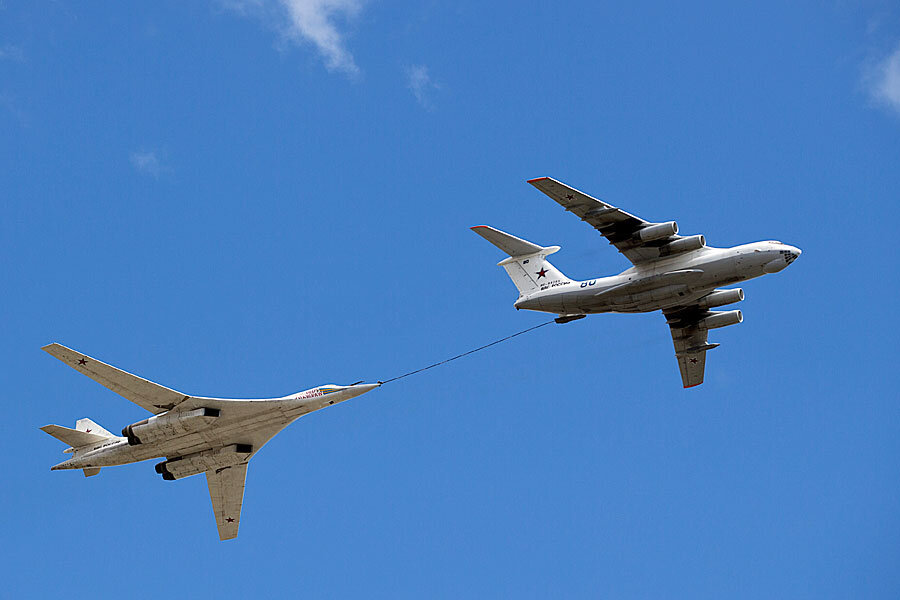Russian bombers over Crimea part of post-Cold War military strategy
Loading...
| London
Holding military drills on Ukraine's border and sending bombers to the edge of NATO airspace – or over Crimea, Russia's newly reformed armed forces are in just the kind of regional confrontation it was redesigned for, experts say.
Moscow has increased defense spending by about 30 percent since its 2008 war with Georgia, and those who study it say the money has been spent not just on hardware but on a much more flexible military structure.
The result, they say, is a more streamlined force that can mobilize key units in a matter of days and support President Vladimir Putin's goal to reassert Russian influence over countries it once controlled within the former Soviet Union.
On Saturday, Russian bombers were spotted refueling over Crimea, reports Agence France Presse.
A local aviation expert told AFP on Sunday that he had sighted a number of planes over the peninsula's main city of Simferopol on Saturday, including supersonic heavy strategic bombers and heavy military transport aircraft.
The expert, who spoke on condition of anonymity, said he had also seen refuelling tankers and MiG-29 jets.
Earlier this month, NATO's top military leader U.S. Air Force General Philip Breedlove said the forces currently arrayed along Ukraine's border could overwhelm the troubled state's forces in as little as five days.
Their deployment may be as much about intimidating the new government in Kiev and keeping it from sending heavier forces to Russian-speaking areas of eastern Ukraine, where pro-Moscow separatists have seized government buildings in several towns.
With Russian nuclear bombers flying the length of the North Sea last Wednesday, prompting NATO jets to scramble, and a fighter conducting a mock attack on a U.S. destroyer earlier in the month, it is also testing the Western response.
"The Russian military has done a lot of thinking about operations other than war, and has deliberately designed itself to be much more flexible," says Keir Giles, a former Russia expert at the UK Defence Academy and now senior fellow at Chatham House, an international affairs think-tank.
Analysts say the reforms pushed forward by Putin and his defence ministers were aimed at making the military much more limber. It might lack Washington's ability to deploy across the world, but it is now much more capable closer to home.
In the Cold War era, much of Russia's army was built around theoretically giant but effectively skeleton divisions of officers and equipment that would be fleshed out with conscripts or reservists to operate during war. Many have now been replaced with much smaller brigades staffed at full strength and drilled with snap exercises to test battle readiness.
Preplanned exercises have also become larger, often held in border areas, which reminds neighbours what they could be up against if they get on the wrong side of Putin.
August's Zapad-13 exercise in Belarus involved up to 70,000 personnel plus bombers, fighters and about 30 warships. Training took place close to the Baltic state and Polish borders and, some Western officials say, appeared to conclude with a mock nuclear strike on a NATO member state.
"We see a rapidly increasing Russian capability to mount large-scale, complex military operations in its neighbourhood," Swedish Maj. Gen. Karlis Neretnieks wrote in a review for the Royal Swedish Academy Of War Sciences.
TESTING BOUNDARIES
Russia's western military district, some analysts believe, has received disproportionate attention when it comes to equipment and training. It faces Ukraine and NATO's Eastern European members, with the Baltic states saying low-level Russian training along its borders now seems almost continuous.
Units along Ukraine's borders seem to have Moscow's latest equipment.
According to the International Institute for Strategic Studies, videos posted online by Russian news and other sites showed the T-72B3, the latest model of a Cold War-era tank, operating near Ukraine. Upgrades are believed to include a new fire control system, a ballistics computer to improve accuracy, thermal sights and improved armour.
While Washington has signalled it will not send troops to Ukraine, it has sent forces to reinforce eastern NATO states, including paratroopers and jets to the Baltics.
U.S. ambassador to NATO Douglas Lute said a recent fall in the number of Russian aircraft approaching the Baltic states was probably a result of that commitment.
The Kremlin appears keen to test such boundaries.
Last Wednesday Britain, Denmark and Holland all scrambled jets in response to a Russian nuclear bomber flight near their territories, patrols that Moscow resumed in 2008.
More unusually, a single Russian SU-24 jet conducted an apparent simulated attack on the destroyer USS Donald Cook in the Black Sea on April 12.
"Russian action seems designed to establish a de facto sphere of influence, to see the areas where the West will respond," said Nikolas Gvosdev, professor of national security studies at the U.S. Naval War College. (Additional reporting by Adrian Croft in Brussels, Aija Krutaine in Riga, David Mardiste in Talinn and Andrius Sytas in Lithuania; Editing by Will Waterman)







